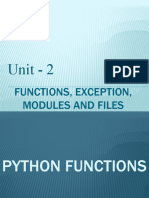0% found this document useful (0 votes)
10 views29 pagesChapter 4 Functions
The document provides an overview of functions in Python, including their definition, types (built-in and user-defined), and the significance of indentation in structuring code. It explains how to call functions, return values, and the different types of arguments (required, keyword, default, and variable-length) that can be used. Additionally, it highlights the advantages of user-defined functions in organizing and managing code effectively.
Uploaded by
gavvalanaveen52Copyright
© © All Rights Reserved
We take content rights seriously. If you suspect this is your content, claim it here.
Available Formats
Download as PPTX, PDF, TXT or read online on Scribd
0% found this document useful (0 votes)
10 views29 pagesChapter 4 Functions
The document provides an overview of functions in Python, including their definition, types (built-in and user-defined), and the significance of indentation in structuring code. It explains how to call functions, return values, and the different types of arguments (required, keyword, default, and variable-length) that can be used. Additionally, it highlights the advantages of user-defined functions in organizing and managing code effectively.
Uploaded by
gavvalanaveen52Copyright
© © All Rights Reserved
We take content rights seriously. If you suspect this is your content, claim it here.
Available Formats
Download as PPTX, PDF, TXT or read online on Scribd
/ 29























































































